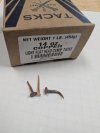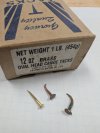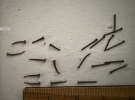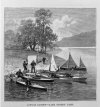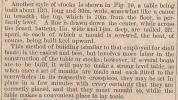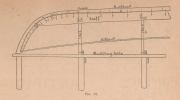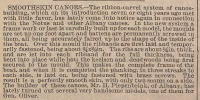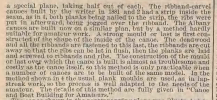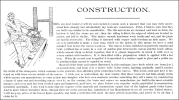Howard Herman-Haase
hcubed
Rethinking the History Maine Canvas Canoes
The idea that some early Maine builders, such as Gerrish, began their careers by simply substituting canvas for bark is not new, but up until recently we didn’t know much of anything about them, so many assumed that they were likely a brief and somewhat crude interlude between the bark and wood-canvas canoes, and that the latter emerged soon after Gerrish started building canvas canoes in 1875. But now it seems likely that Gerrish was building them for at least twelve years (1875-1877), because according to Morris all the early Maine canvas canoes were built “after the principle of the birch-bark canoes, of loose ribs and planking with a tight skin of canvas” until he adopted the "method of the solid planked shell […], which instead of putting the woodwork into the canvas, caused the canvas to be drawn over the solid planked shell” at his first factory in 1887. Although it is unclear whether or not Morris initially used canoe forms to build these shells, I think this event is presently our best candidate for the beginning of the Maine wood-canvas canoe. Although Gerrish and Morris quickly moved on to the wood-canvas canoes, some indigenous communities in Eastern Canada would continue building the original Maine canvas canoes until the middle of the twentieth century. So the original Maine canvas canoes should be considered a distinct and unique canoe building tradition that began in Maine with Gerrish and was quickly adopted by both non-indigenous and indigenous builders. Most non-indigenous builders turned to the wood-canvas canoe during the final two years of the 1880s, while among indigenous builders, it spread regionally and was used by some communities into the mid-twentieth century.
Descriptions indicate that the quality of materials and construction of these canoes was anything but crude. Gerrish tells us in 1882 that the lumber he used “[was] of the very best quality, knots and sap being inadmissible in canoe building,” and “the strength of the combination of frail materials [was] wonderful.” He also argued among other things that “canvas covering admits of far more graceful outline than the birch, especially at the ends, where the latter is generally lumpy and unsightly with liberal applications of pitch.” The canvas canoe Gerrish sent to the New Orleans Exposition in late 1884 was described as follows.

Other examples include two Gerrish canvas canoes displayed at the New England Fair in 1885.

Kirkpatrick canvas canoes from 1885,

and two Morris canvas canoes displayed at Bangor in 1886.
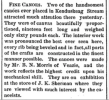
[I will post some photos of original Maine canvas canoes in a separate post, which also suggest that some Maine builders had mastered this building technique and were producing high quality canoes that were in general appearance indistinguishable from the later wood-canvas canoes.]
These original Maine canvas canoe set the stage for the wood-canvas canoe by normalizing the use of canvas in Maine canoe building, and ultimately displacing the “Birch” as the pre-eminent canoe in the Maine tourist industry. In other words, it was the original Maine canvas canoe, not the wood-canvas canoe, that successfully transformed the traditional birch bark building tradition into a nascent canvas canoe building tradition in Maine. This transition took more than a decade, but as the superior durability of canvas became more widely understood, and the supply of suitable bark diminished the original canvas canoe ultimately prevailed. During the 1880s descriptions of Moosehead Lake, the epicenter of the Maine tourist industry, reveal the continuous encroachment of canvas canoes. Farrar’s famous Illustrated Guide of Moosehead Lake was recommending canvas canoes for “rough work” by 1880.

By 1881 the standard options for a canoe at Moosehead Lake, were one “made of birch bark or canvas, painted" These canvas canoes became so common at the Lake that some sources describe the canoe Gerrish sent to the New Orleans in 1884 as “a canvass canoe such as is used at Moosehead Lake.” An article originally published in the New York Sun in 1885, which was picked up by several national periodicals and newspapers (see Dan’s Post #51) acknowledged that “many cloth canoes” had been built over the previous ten years, and that when painted they were watertight, and "lighter, and just as cheap as the birch,” but insisted "birch would never be displace by canvas [because] it bends in prettier forms."
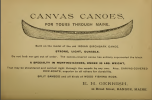
A couple of years later a reworked version of this article appeared as a letter, but now claimed "a great many [canvas canoes} were being built at Bangor,” and that in addition to bending in prettier forms than canvas, bark was also "a more romantic material.” Various versions of this article also circulated among national publications. One of the latest versions in the Lawrence Daily Journal (Kansas) from August 1888 was titled Birch Bark Canoes, but nonetheless began, “Birch and canvas canoes are greatly increasing in popularity [and …] at most of the summer resorts they supersede all other craft that have to be propelled by hand,” and later reports that “Several years ago canvas began to be used extensively in canoe-building” and that there were ”several canvas canoe factories in Maine, but the canoes made of canvas have neither the symmetry nor the durability of the birches” and that “if pleasure and profit are wanted one should never have any thing but a bark craft.” Even as the canvas canoes continued to displace the birch in the Maine tourist industry, its advocates still took solace in the belief that canvas “[would] never entirely supersede the birch.”

But as the national press debated the future of the Birch, the local newspapers made it clear that the unimaginable was already happening, and the 1889 edition of Lucius Hubbard’s Guide to Moosehead Lake described a similar state of affairs in a paragraph he added to the lengthy section on birch-bark canoes that appeared in all previous editions.
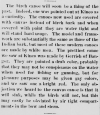
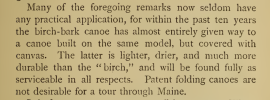
Gerrish also published his first display in this edition of Hubbard’s Guidebook to Moosehead Lake, in which he declared that, “The canvas-covered canoe has entirely superseded the birch.” Although he was likely building solid planked wood canvas canoes by then, it was his original Maine canvas canoe, that had accomplished this difficult task, and completed the first milestone in the history of Maine’s canvas canoes.

But the original Maine canvas canoes were very much a Maine thing, and even though by 1881 Gerrish had been listed in The New England Business Directory, the Maine State Year Book, and the Bangor City Directory, most of his orders came form sportsmen and tourists who had direct experience with his canoes in Maine.
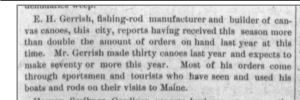
Consequently, demand was limited, and although Gerrish was the most prolific builder at this time, he made only 30 canoes in 1885, and despite the claim he would build over seventy canoes in 1886, later sources report he only made 60 in 1888. But demand was not the only problem; the building method of the original canvas canoes did not lend itself to large scale production. The solid planked shell and eventual adoption of canoe forms in wood-canvas canoe construction would solve this problem, and by 1890 both Gerrish and Morris were confident enough to enter the national market place, and published their first ads in Forest and Stream. At the time the only canvas canoes available in the national market place were the very popular portable folding canvas boats, and part of appeal of the original canvas canoes was that they had allowed the local canoe building industry to ward off this outside competition in Maine. The wood canvas canoe would quickly surpass the original canvas canoes in Maine between 1887-1889, and then compete directly with the portable folding canvas boats in the national market place, eventually surpassing them, and becoming, arguably, the most popular type of canoe in the country. So the history of canvas canoes in Maine is best thought of as consisting of two distinct phases; (1) the original canvas canoe's displacement of the bark canoes as the dominant canoe in the Maine tourist industry between 1875 and 1889, and (2) the wood-canvas canoe’s subsequent displacement of the portable folding canvas canoes (and for many the all-wood canoes) as the dominant canoe in the national marketplace between 1890 and about 1920.
The idea that some early Maine builders, such as Gerrish, began their careers by simply substituting canvas for bark is not new, but up until recently we didn’t know much of anything about them, so many assumed that they were likely a brief and somewhat crude interlude between the bark and wood-canvas canoes, and that the latter emerged soon after Gerrish started building canvas canoes in 1875. But now it seems likely that Gerrish was building them for at least twelve years (1875-1877), because according to Morris all the early Maine canvas canoes were built “after the principle of the birch-bark canoes, of loose ribs and planking with a tight skin of canvas” until he adopted the "method of the solid planked shell […], which instead of putting the woodwork into the canvas, caused the canvas to be drawn over the solid planked shell” at his first factory in 1887. Although it is unclear whether or not Morris initially used canoe forms to build these shells, I think this event is presently our best candidate for the beginning of the Maine wood-canvas canoe. Although Gerrish and Morris quickly moved on to the wood-canvas canoes, some indigenous communities in Eastern Canada would continue building the original Maine canvas canoes until the middle of the twentieth century. So the original Maine canvas canoes should be considered a distinct and unique canoe building tradition that began in Maine with Gerrish and was quickly adopted by both non-indigenous and indigenous builders. Most non-indigenous builders turned to the wood-canvas canoe during the final two years of the 1880s, while among indigenous builders, it spread regionally and was used by some communities into the mid-twentieth century.
Descriptions indicate that the quality of materials and construction of these canoes was anything but crude. Gerrish tells us in 1882 that the lumber he used “[was] of the very best quality, knots and sap being inadmissible in canoe building,” and “the strength of the combination of frail materials [was] wonderful.” He also argued among other things that “canvas covering admits of far more graceful outline than the birch, especially at the ends, where the latter is generally lumpy and unsightly with liberal applications of pitch.” The canvas canoe Gerrish sent to the New Orleans Exposition in late 1884 was described as follows.

Other examples include two Gerrish canvas canoes displayed at the New England Fair in 1885.
Kirkpatrick canvas canoes from 1885,

and two Morris canvas canoes displayed at Bangor in 1886.

[I will post some photos of original Maine canvas canoes in a separate post, which also suggest that some Maine builders had mastered this building technique and were producing high quality canoes that were in general appearance indistinguishable from the later wood-canvas canoes.]
These original Maine canvas canoe set the stage for the wood-canvas canoe by normalizing the use of canvas in Maine canoe building, and ultimately displacing the “Birch” as the pre-eminent canoe in the Maine tourist industry. In other words, it was the original Maine canvas canoe, not the wood-canvas canoe, that successfully transformed the traditional birch bark building tradition into a nascent canvas canoe building tradition in Maine. This transition took more than a decade, but as the superior durability of canvas became more widely understood, and the supply of suitable bark diminished the original canvas canoe ultimately prevailed. During the 1880s descriptions of Moosehead Lake, the epicenter of the Maine tourist industry, reveal the continuous encroachment of canvas canoes. Farrar’s famous Illustrated Guide of Moosehead Lake was recommending canvas canoes for “rough work” by 1880.

By 1881 the standard options for a canoe at Moosehead Lake, were one “made of birch bark or canvas, painted" These canvas canoes became so common at the Lake that some sources describe the canoe Gerrish sent to the New Orleans in 1884 as “a canvass canoe such as is used at Moosehead Lake.” An article originally published in the New York Sun in 1885, which was picked up by several national periodicals and newspapers (see Dan’s Post #51) acknowledged that “many cloth canoes” had been built over the previous ten years, and that when painted they were watertight, and "lighter, and just as cheap as the birch,” but insisted "birch would never be displace by canvas [because] it bends in prettier forms."

A couple of years later a reworked version of this article appeared as a letter, but now claimed "a great many [canvas canoes} were being built at Bangor,” and that in addition to bending in prettier forms than canvas, bark was also "a more romantic material.” Various versions of this article also circulated among national publications. One of the latest versions in the Lawrence Daily Journal (Kansas) from August 1888 was titled Birch Bark Canoes, but nonetheless began, “Birch and canvas canoes are greatly increasing in popularity [and …] at most of the summer resorts they supersede all other craft that have to be propelled by hand,” and later reports that “Several years ago canvas began to be used extensively in canoe-building” and that there were ”several canvas canoe factories in Maine, but the canoes made of canvas have neither the symmetry nor the durability of the birches” and that “if pleasure and profit are wanted one should never have any thing but a bark craft.” Even as the canvas canoes continued to displace the birch in the Maine tourist industry, its advocates still took solace in the belief that canvas “[would] never entirely supersede the birch.”

But as the national press debated the future of the Birch, the local newspapers made it clear that the unimaginable was already happening, and the 1889 edition of Lucius Hubbard’s Guide to Moosehead Lake described a similar state of affairs in a paragraph he added to the lengthy section on birch-bark canoes that appeared in all previous editions.


Gerrish also published his first display in this edition of Hubbard’s Guidebook to Moosehead Lake, in which he declared that, “The canvas-covered canoe has entirely superseded the birch.” Although he was likely building solid planked wood canvas canoes by then, it was his original Maine canvas canoe, that had accomplished this difficult task, and completed the first milestone in the history of Maine’s canvas canoes.

But the original Maine canvas canoes were very much a Maine thing, and even though by 1881 Gerrish had been listed in The New England Business Directory, the Maine State Year Book, and the Bangor City Directory, most of his orders came form sportsmen and tourists who had direct experience with his canoes in Maine.

Consequently, demand was limited, and although Gerrish was the most prolific builder at this time, he made only 30 canoes in 1885, and despite the claim he would build over seventy canoes in 1886, later sources report he only made 60 in 1888. But demand was not the only problem; the building method of the original canvas canoes did not lend itself to large scale production. The solid planked shell and eventual adoption of canoe forms in wood-canvas canoe construction would solve this problem, and by 1890 both Gerrish and Morris were confident enough to enter the national market place, and published their first ads in Forest and Stream. At the time the only canvas canoes available in the national market place were the very popular portable folding canvas boats, and part of appeal of the original canvas canoes was that they had allowed the local canoe building industry to ward off this outside competition in Maine. The wood canvas canoe would quickly surpass the original canvas canoes in Maine between 1887-1889, and then compete directly with the portable folding canvas boats in the national market place, eventually surpassing them, and becoming, arguably, the most popular type of canoe in the country. So the history of canvas canoes in Maine is best thought of as consisting of two distinct phases; (1) the original canvas canoe's displacement of the bark canoes as the dominant canoe in the Maine tourist industry between 1875 and 1889, and (2) the wood-canvas canoe’s subsequent displacement of the portable folding canvas canoes (and for many the all-wood canoes) as the dominant canoe in the national marketplace between 1890 and about 1920.


